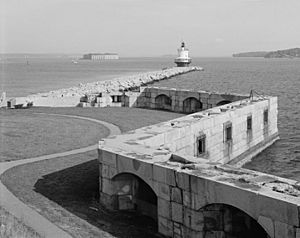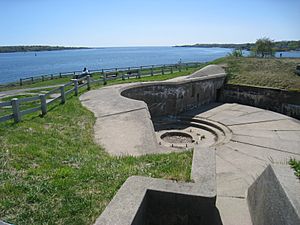Fort Preble facts for kids
Quick facts for kids Fort Preble |
|
|---|---|
| Part of Harbor Defenses of Portland | |
| South Portland, Maine | |

Fort Preble, showing some of the incomplete Third System casemates built during the Civil War. Spring Point Ledge Light and Fort Gorges are in the background.
|
|
|
Location in Maine
|
|
| Coordinates | 43°38′55″N 70°13′35″W / 43.64861°N 70.22639°W |
| Type | Coastal Defense |
| Site information | |
| Owner | Southern Maine Community College |
| Open to the public |
yes |
| Site history | |
| Built | 1808 |
| Built by | United States Army |
| In use | 1808–1950 |
| Battles/wars | War of 1812 American Civil War World War I World War II |
Fort Preble is an old military fort located in South Portland, Maine. It was built in 1808 and was used by the United States Army for many years. Today, it is part of the campus of Southern Maine Community College. This fort played an important role in protecting the coast of Maine during several major wars.
Contents
Building Fort Preble
The idea for Fort Preble came from Henry Dearborn, who was like the head of the army for the United States. He gave the order to build the fort in 1808. His son, Henry A. S. Dearborn, helped make sure the construction happened. The fort was named after Edward Preble, a brave naval leader who had fought in the Barbary Wars. Commodore Preble passed away in Portland in 1807.
Fort Preble was part of a big plan to build forts along the US coast. It was designed as a "star fort," meaning it had a star shape. It was made from stone, brick, and grass, and had 14 large cannons. These cannons included two huge 50-pounder guns called Columbiads. The fort also had buildings for soldiers to live in.
Fort Preble and another nearby fort, Fort Scammell, were built to protect against attacks. At the time, the United States was worried about getting involved in wars between Great Britain and France. In 1808, soldiers were sent to Fort Preble. They were told to stop ships that were breaking the Embargo Act. This act was an attempt to punish Britain and France by stopping trade with them. It was not popular in New England, and it eventually led to the War of 1812.
Fort Preble During the War of 1812
Many different groups of soldiers served at Fort Preble during the War of 1812. These included regular army soldiers and local volunteer groups.
An interesting event happened at the fort during this war. When American soldiers were released from being prisoners in Canada, they were brought to Fort Preble. Many of them were very sick and weak. Some even died at the fort's hospital.
Later, from 1848 to 1849 and again from 1851 to 1853, a famous officer named Robert Anderson commanded Fort Preble. He would later become well-known for defending Fort Sumter at the start of the Civil War. Around 1845, Fort Preble also got new cannon areas, including a 12-gun North Battery and a 10-gun South Battery.
The Civil War Years
During the American Civil War, Fort Preble became an important place. It was the main office and training center for the 17th US Infantry Regiment. It was also where volunteer soldiers from Maine gathered before going to war.
Soldiers from Fort Preble even saw action in 1863. Some Confederate raiders came into Portland Harbor on a captured ship. They took another US ship, the Caleb Cushing. Soldiers and cannons from Fort Preble, along with civilian volunteers, chased them. The Confederates couldn't escape and set their ship on fire. The Caleb Cushing exploded and sank. Twenty-three Confederate prisoners were captured and brought to Fort Preble.
During this time, Major George Lippitt Andrews was in charge of Fort Preble. He was a brave officer who later commanded an African-American regiment called the 25th Infantry.
A sad event happened at Fort Preble in 1863. A soldier named Billy Laird was executed by a firing squad for leaving his post. President Abraham Lincoln had actually pardoned him, but the message never arrived. This was because the telegraph wires in New York City were cut during riots there. Billy Laird was the only soldier from Maine in the Civil War to be executed for leaving his post.
During the Civil War, there were plans to make Fort Preble much bigger. The old star fort would stay to protect the land side. New stone gun positions, called casemates, were planned for the water sides. However, this big expansion was never fully finished. Some of these incomplete casemates can still be seen today.
After the Civil War
In the 1870s, Fort Preble was updated by an army engineer named Thomas Lincoln Casey Sr.. He is also famous for finishing the Washington Monument. These updates included new places for very large cannons. These cannons were placed behind dirt walls, because it was found that stone walls couldn't stand up to the new, more powerful cannon shells.
Fort Preble in the 20th Century

Between 1896 and 1906, modern coastal defense batteries were added to Fort Preble. These were part of the Harbor Defenses of Portland, which included other forts like Fort Williams. The old star fort was taken down to make space for these new batteries.
Batteries Kearny and Chase had a total of sixteen huge 12-inch cannons called mortars. These were completed in 1901. In 1906, Battery Rivardi was added with two "disappearing guns." These 6-inch guns would pop up to fire and then lower back down to be reloaded and protected. Battery Mason had one 3-inch gun.
Fort Preble was still active during World War I. Some of its big guns were sent to France to help with the fighting there. For example, Battery Rivardi's two 6-inch guns were shipped away in 1917 and never returned. Some of the mortars were also removed. This left Fort Preble with eight mortars and one 3-inch gun.
In 1924, the army organized its coastal defense units into regiments. The 8th Coast Artillery Regiment was formed at Fort Preble. A reserve group, the 240th Coast Artillery, was also created. Both of these groups protected Portland Harbor during the early part of World War II. During World War II, Fort Preble was used to store naval nets and as a control station for a special system to protect ships from magnetic mines. All the remaining mortars were removed in 1942. Fort Preble was replaced by newer defenses, especially Battery Steele on Peaks Island. The last 3-inch gun was removed in 1946.
After World War II, it was decided that old coastal forts were no longer needed. Fort Preble, like many other forts, was closed down in 1950.
An Educational Place Today
In 1952, the State of Maine bought the fort. It became the campus for a technical college, which is now called Southern Maine Community College (SMCC).
Some of Fort Preble's original brick buildings from the early 1900s are still standing. These include officers' homes, barracks (where soldiers lived), and a fire station. They are well-preserved.
The Spring Point Ledge Light lighthouse was built near the fort in 1897. A long, 900-foot granite wall, called a breakwater, was added in 1951. It extends from the fort and surrounds the lighthouse, protecting it from waves.



